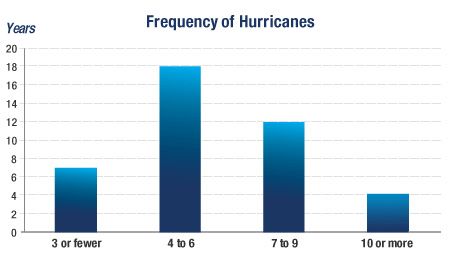A Look Back at The 2010 Hurricane Season
This Atlantic hurricane season was marked by intense storm activity which however resulted in little disruption across the United States. While the season spawned 12 hurricanes, none hit land on U.S. shores. Latin America was not so lucky, especially Mexico which was rocked by Hurricane Karl. We in the U.S. have the position of the jet stream this year to thank for our good fortune, as it diverted many of the storms back to sea.

Heading into May the National Oceanic and Atmospheric Administration (NOAA) Climate Prediction Center (CPC) projected a 70% chance that the season would produce between 8 to 14 hurricanes and emphasized their leaning towards the larger end of the spectrum based on record warmth for surface water temperatures and the presence of La Nina. In light of their recent track record of incorrectly predicting the last three out four years, this year's projection seemed like a stretch. Especially when you consider that prior to this year on three times in the past forty years had the number of hurricanes reached double digits. Thus, we must give credit to the NOAA forecasters for accurately predicting that this year would be one of the most active hurricane seasons on record.
WHAT DO YOU THINK?
Generated by readers, the comments included herein do not reflect the views and opinions of Rigzone. All comments are subject to editorial review. Off-topic, inappropriate or insulting comments will be removed.
- How Likely Is an All-Out War in the Middle East Involving the USA?
- Rooftop Solar Now 4th Largest Source of Electricity in Australia
- US Confirms Reimposition of Oil Sanctions against Venezuela
- Analyst Says USA Influence on Middle East Seems to be Fading
- EU, Industry Players Ink Charter to Meet Solar Energy Targets
- Russian Ships to Remain Banned from US Ports
- Brazil Court Reinstates Petrobras Chair to Divided Board
- EIB Lends $425.7 Million for Thuringia's Grid Upgrades
- Var Energi Confirms Oil Discovery in Ringhorne
- Seatrium, Shell Strengthen Floating Production Systems Collaboration
- An Already Bad Situation in the Red Sea Just Got Worse
- What's Next for Oil? Analysts Weigh In After Iran's Attack
- USA Regional Banks Dramatically Step Up Loans to Oil and Gas
- EIA Raises WTI Oil Price Forecasts
- How Likely Is an All-Out War in the Middle East Involving the USA?
- Venezuela Authorities Arrest Two Senior Energy Officials
- Namibia Expects FID on Potential Major Oil Discovery by Yearend
- Oil Markets Were Already Positioned for Iran Attack
- Is The Iran Nuclear Deal Revival Project Dead?
- Petrobras Chairman Suspended
- Oil and Gas Executives Predict WTI Oil Price
- An Already Bad Situation in the Red Sea Just Got Worse
- New China Climate Chief Says Fossil Fuels Must Keep a Role
- Oil and Gas Execs Reveal Where They See Henry Hub Price Heading
- Equinor Makes Discovery in North Sea
- Macquarie Strategists Warn of Large Oil Price Correction
- DOI Announces Proposal for Second GOM Offshore Wind Auction
- Standard Chartered Reiterates $94 Brent Call
- Chevron, Hess Confident Embattled Merger Will Close Mid-2024
- Analysts Flag 'Remarkable Feature' of 2024 Oil Price Rally


